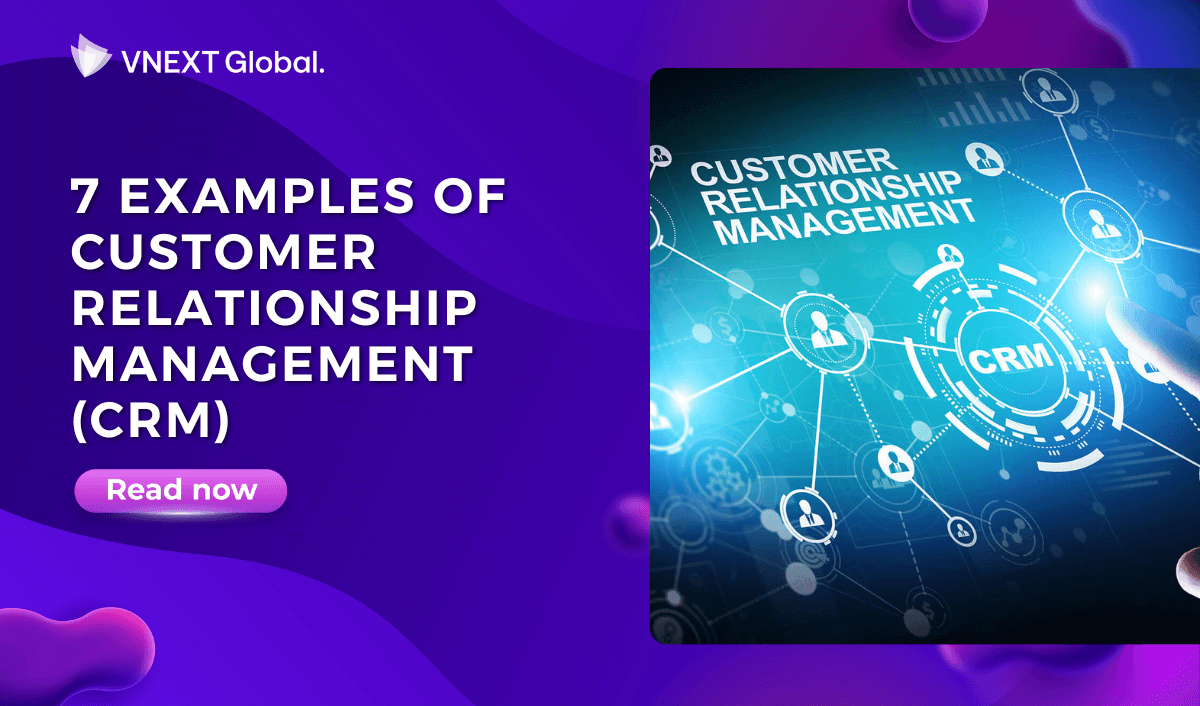7 Examples of Customer Relationship Management (CRM)
In today's hyper-competitive business world, companies need to have a strong focus on building and maintaining positive relationships with their customers. A well-executed CRM strategy can help businesses improve customer retention rates, increase sales, and drive growth. According to a study by Bain & Company, increasing customer retention rates by just 5% can increase profits by 25-95%. This highlights the potential impact a strong CRM strategy can have on a business's bottom line.
In this blog, we'll be exploring seven examples of customer relationship management implemented by leading companies across various industries. From personalized marketing campaigns to effective customer support systems, these examples will provide valuable insights into how businesses can leverage CRM to enhance customer experiences and drive business success. So, let's dive in and discover the world of CRM!
1. What is customer relationship management (CRM)?
Customer Relationship Management (CRM) is the process of managing interactions with customers to improve customer satisfaction, loyalty, and retention. CRM includes a range of strategies, tools, and technologies that enable companies to collect and analyze customer data, personalize interactions, and deliver targeted messaging across multiple channels. Effective CRM strategies can help companies to increase revenue, reduce costs, and build stronger relationships with customers.
To grasp a comprehensive idea about this approach, let’s delve into CRM model by Amazon, the world's largest online retailer. Amazon's CRM model is built around the concept of personalized customer experiences. The company uses customer data to provide customized recommendations and offers based on each customer's preferences and past behavior.
Amazon's CRM model is supported by advanced technology, including machine learning and artificial intelligence. The company uses these technologies to analyze customer data in real time and provide personalized recommendations based on each customer's browsing and purchase history.
Amazon's CRM model has been extremely effective in driving customer loyalty and repeat business. The company has a customer retention rate of over 90%, which is significantly higher than the industry average. By providing personalized experiences and recommendations, Amazon has built a strong bond with its customers and created a competitive advantage in the e-commerce industry.
Some key takeaways from Amazon's CRM model include:
- Personalization is key: By providing personalized experiences and recommendations, companies can build stronger relationships with their customers and increase loyalty.
- Advanced technology is essential: To effectively analyze customer data and provide personalized recommendations in real-time, companies need to invest in advanced technology like machine learning and artificial intelligence.
- Customer retention is crucial: By retaining existing customers and encouraging repeat business, companies can improve their bottom line and gain a competitive advantage in their industry.
Impressive, right? So, after thoroughly examining this successful model, let’s take a closer look at some examples of Customer Relationship Management (CRM) to explore how businesses have implemented this powerful system in their marketing strategies.

2. 7 Examples of Customer Relationship Management
A. Personalization:
Personalization refers to using customer data to create customized experiences, messaging, and offers. Companies can use a variety of data sources, including customer profiles, purchase history, and web browsing behavior, to personalize interactions with customers. Personalization can improve the customer experience by delivering targeted messaging that resonates with each customer's unique preferences and needs. Personalization can also increase customer loyalty, as customers are more likely to continue doing business with companies that demonstrate an understanding of their needs.
- Benefits:
Personalization can improve customer satisfaction, loyalty, and retention. It can also increase sales by delivering targeted offers and messaging that are more likely to result in a purchase.
- Key takeaways:
To implement effective personalization, companies should collect and analyze customer data, segment customers based on their preferences and needs, and deliver targeted messaging across multiple channels.
- Case study:
Netflix uses personalization to recommend movies and TV shows to customers based on their viewing history. By analyzing customer viewing patterns regarding movie categories, genres, etc. , Netflix can deliver highly targeted recommendations that are more likely to result in customer satisfaction and retention.
B. Loyalty programs:
Loyalty programs reward customers for their continued business by offering incentives, such as points, discounts, or exclusive offers. Loyalty programs can improve customer retention by incentivizing customers to continue doing business with a company, even in the face of competitive offers. Loyalty programs can also increase customer engagement and advocacy by creating a sense of community and exclusivity among members.
Benefits: Loyalty programs can improve customer retention, engagement, and advocacy. They can also increase revenue by encouraging customers to make repeat purchases and refer new customers.
Key takeaways: To implement effective loyalty programs, companies should offer valuable incentives, segment customers based on their preferences and needs, and regularly communicate program benefits and offers to members.
Real-world case study: Starbucks offers a loyalty program that rewards customers with stars for each purchase. Customers can redeem stars for free drinks, food, and other rewards. The program has over 19 million members and has been credited with increasing customer engagement and loyalty.
C. Customer service:
Customer service involves providing timely and personalized assistance to customers across multiple channels, including phone, email, chat, and social media. Effective customer service can improve customer satisfaction and retention by addressing customer needs and concerns in a timely and effective manner. Good customer service can also increase customer advocacy by creating positive experiences and impressions.
- Benefits:
Good customer service can improve customer satisfaction, retention, and advocacy. It can also reduce customer churn by addressing issues and concerns before they escalate.
- Key takeaways:
To implement effective customer service, companies should prioritize customer needs and concerns, provide timely and personalized assistance across multiple channels, and regularly monitor customer feedback and sentiment.
- Real-world case study:
Zappos is known for its exceptional customer service, which includes free shipping and returns, 24/7 support, and a team of dedicated customer service representatives who are empowered to go above and beyond to meet customer needs.
.png)
D. Customer feedback:
Customer feedback involves actively seeking out customer opinions and preferences through surveys, focus groups, and social media. Customer feedback can provide valuable insights into customer needs and preferences, and help companies to improve products, services, and overall customer experience. By listening to customer feedback and acting on it, companies can demonstrate their commitment to customer satisfaction and build stronger relationships with customers.
- Benefits:
Customer feedback can provide valuable insights into customer needs and preferences, and help companies to improve products, services, and overall customer experience. It can also improve customer satisfaction and loyalty by demonstrating a commitment to listening and acting on customer feedback.
- Key takeaways:
To implement effective customer feedback strategies, companies should regularly seek out customer opinions and preferences, analyze feedback data, and take action to address areas for improvement.
- Real-world case study:
Amazon regularly solicits customer feedback through surveys and reviews and uses this feedback to improve its products, services, and overall customer experience. For example, Amazon's customer reviews have helped to identify product defects and improve product quality.
E. Cross-selling and upselling:
Cross-selling and upselling involve offering customers additional products or services that complement or enhance their existing purchases. Cross-selling and upselling can increase revenue per customer by encouraging them to make additional purchases. They can also improve customer satisfaction by offering customers products or services that meet their evolving needs.
- Benefits:
Cross-selling and upselling can increase revenue per customer and improve customer satisfaction by offering products or services that meet their evolving needs.
- Key takeaways:
To implement effective cross-selling and upselling strategies, companies should analyze customer purchase data to identify opportunities for additional sales, offer products or services that complement or enhance existing purchases, and communicate the benefits of these offerings to customers.
- Real-world case study:
Amazon uses cross-selling and upselling to offer customers additional products and services based on their purchase history and browsing behavior. For example, when a customer purchases a book, Amazon may recommend related books or offer a subscription to Audible, its audiobook service.
F. Marketing automation:
Marketing automation involves using technology to automate repetitive marketing tasks, such as email marketing, social media posting, and lead nurturing. Marketing automation can improve efficiency and scalability by allowing companies to reach a larger audience with personalized messaging and offers. It can also improve customer engagement and loyalty by delivering relevant and timely messaging across multiple channels.
- Benefits:
Marketing automation can improve efficiency and scalability, and increase customer engagement and loyalty by delivering relevant and timely messaging across multiple channels.
- Key takeaways:
To implement effective marketing automation strategies, companies should use customer data to create personalized messaging and offers, automate repetitive marketing tasks, and regularly analyze campaign performance to optimize results.
- Real-world case study:
HubSpot offers a marketing automation platform that allows companies to automate their marketing tasks and deliver personalized messaging and offers across multiple channels. The platform has been credited with increasing customer engagement and loyalty.
G. Social media management:
Social media management involves managing a company's social media presence and interactions with customers across multiple platforms, such as Facebook, Twitter, and Instagram. Social media management can improve customer engagement and advocacy by providing a platform for customers to connect with companies and share their experiences. It can also improve customer satisfaction by providing timely and personalized assistance to customers through social media channels.
- Benefits:
Social media management can improve customer engagement and advocacy, and provide timely and personalized assistance to customers through social media channels.
- Key takeaways:
To implement effective social media management strategies, companies should regularly monitor social media channels for customer feedback and sentiment, provide timely and personalized assistance to customers, and create engaging content that resonates with their target audience.
- Real-world case study:
JetBlue has been praised for its effective social media management, which includes a dedicated team of social media representatives who engage with customers on Twitter and other platforms. JetBlue's social media team has been credited with improving customer satisfaction and advocacy.

3. How to know which customer relationship management type match your requirements?
To determine which customer relationship management type matches your requirements, you should consider several factors:
A. Your business goals:
What are your primary business goals? Are you focused on acquiring new customers, retaining existing customers, or increasing revenue per customer? Different customer relationship management strategies may be more effective depending on your specific goals.
B. Know your audience:
Who are your target customers? What are their needs and preferences? Different customer relationship management strategies may be more effective depending on your target audience and their behaviors.
C. Your resources:
What resources do you have available to invest in customer relationship management? Different strategies may require different levels of investment in terms of time, personnel, and technology.
D. Your current customer relationship management practices:
What customer relationship management practices are you currently using? Are they effective? Which strategies could complement or improve your existing practices?
By considering these factors, you can identify which customer relationship management strategies are most likely to meet your requirements and achieve your business goals.

Final thoughts:
In conclusion, customer relationship management is essential for companies looking to build and maintain strong relationships with their customers. By implementing effective customer relationship management strategies, companies can improve customer satisfaction and loyalty, increase revenue per customer, and gain a competitive advantage in their respective industries. The seven examples of customer relationship management outlined in this article are just a few of the many strategies available to companies today. By carefully considering their business goals, target audience, resources, and existing practices, companies can identify which customer relationship management strategies are most likely to be effective for their specific needs.
If you are looking for a trusted IT partner, VNEXT Global is the ideal choice. With 14+ years of experience, we surely can help you to optimize your business digitalization within a small budget and short time. Currently, we have 400+ IT consultants and developers in Mobile App, Web App, System Development, Blockchain Development and Testing Services. We have provided solutions to 600+ projects in several industries for clients worldwide. We are willing to become a companion on your way to success. Please tell us when is convenient for you to have an online meeting to discuss this further. Have a nice day!












